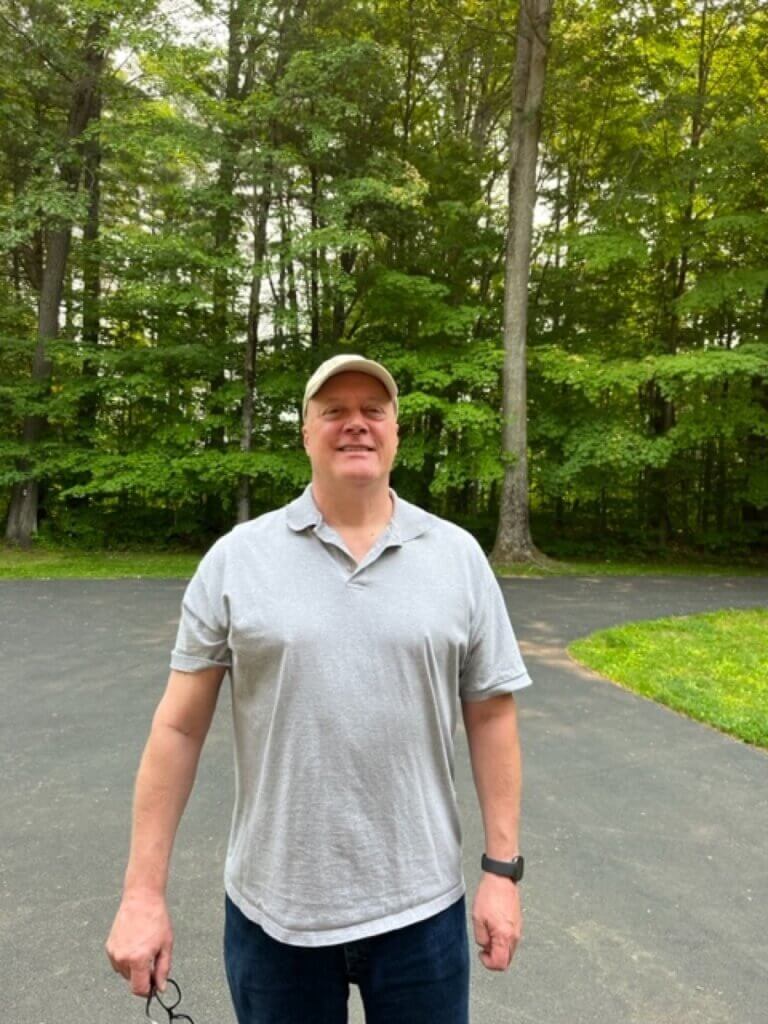In most ways, Bill Ross’s stem cell transplant for multiple myeloma at Dana-Farber Brigham Cancer Center (DFBCC) wasn’t out of the ordinary. He received chemotherapy to destroy the tumor cells in his body and then an infusion of his own hematopoietic stem cells, which flocked to his bone marrow and regenerated his blood supply. Over the course of his treatment, he was carefully monitored, his vital signs measured, and his symptoms eased. A little over three weeks after arriving for his initial chemotherapy treatment, he was discharged and returned home in South Glens Falls, NY, to continue his recovery.
What distinguished Ross’s transplant — and makes it a harbinger of many transplants in the future – is where Ross stayed for most of that three-week period. Instead of remaining in the hospital for the entirety of his treatment, as patients undergoing transplant traditionally have, Ross came to the clinic solely to receive treatment or receive follow-up care and tests. The rest of the time, he was in a nearby hotel with his wife and primary caregiver, Sandy. Only when he developed intestinal inflammation — a common aftereffect of chemotherapy — eight days after transplant was he admitted as a hospital inpatient.
DFBCC has offered reduced-intensity allogeneic (donor) stem cell transplants as an outpatient procedure to some patients with leukemia, but Ross’s marked a new chapter in the center’s transplant program. Not only was Ross the first patient with myeloma to undergo the procedure as an outpatient at DFBCC, but he was also the first whose outpatient transplant was autologous — using his own stem cells — rather than allogenic.
[Learn more: What’s the difference between autologous and allogeneic stem cell transplants?]
The opportunity to spend less time in the hospital is attractive to many patients undergoing transplant, and represents a significant change for a procedure that traditionally has entailed a three-week hospitalization, says Ross’s primary oncologist, Omar Nadeem, MD.
“For patients who are eligible, it can be a win-win,” Nadeem remarks. “They can receive the same level of care and monitoring without some of the annoyances and downsides of an extended hospital stay.”

Deliberating a decision
Ross, 63, came to DFBCC in October of last year after being diagnosed with myeloma at his local hospital. He’d been found to have elevated levels of the IgM protein in his blood, which often indicates Waldenström’s macroglobulinemia but, in Ross’s case, signaled myeloma. He underwent apheresis to reduce the levels of the protein and began standard therapy for myeloma with guidance from Nadeem, who was helping coordinate his care with his local physician.
“When I met with Dr. Nadeem, he suggested a stem cell transplant and said I could potentially receive it as an outpatient,” Ross remarks. Nadeem was clear: the decision of whether to have the transplant done on an outpatient basis — to be the first to do so at DFBCC — rested with Ross.
Ross was a good candidate to trailblaze this approach for several reasons, Nadeem relates. He was healthy enough that he would likely make it through the transplant process without major complications. And, critically, he’d have a reliable and engaged caregiver with him at the hotel — his wife.
Both Nadeem and Irina Dobrusin, RN, BSN, a nurse navigator for the DFBCC multiple myeloma program, who would see Ross throughout the transplant process, were impressed with how knowledgeable Ross and his wife were about stem cell transplantation. “Bill was very informed about the procedure,” Dobrusin says. “He has a good sense of humor and was receptive to what the transplant would entail.”
“It’s natural to be a little nervous about being first,” Nadeem comments. “People think of the hospital as the place where they’ll receive the most care, that has the most resources. We assured Bill and his family that the care he’d receive as an outpatient was identical to what he’d receive as an inpatient — the main difference was that when he wasn’t in the clinic, he’d be in a hotel.”
Ross, who had retired as a co-owner/manager of a bath and skin care products company, admits to a bit of reluctance about being the first person with myeloma to undergo an autologous transplant as an outpatient at DFBCC, but after discussing it with his family, he decided to go ahead. One of the key considerations was whether funding was available to defray some of the cost of the hotel stay. While health insurance pays for hospital stays, it generally doesn’t cover hotel fees, even if they’re incurred in lieu of hospital admission.
Resource specialists at Dana-Farber helped Ross identify sources that can assist with hotel charges. “In the vast majority of cases, we’re able to come up with a good plan so the cost of staying at a hotel doesn’t become prohibitive for patients,” Nadeem remarks.
Over the course of his treatment at DFBCC, Ross was a hospital inpatient for less than a week to receive treatment for the intestinal flare-up he experienced from chemotherapy. That compares with a two-and-a-half- to three-week hospital stay that is the norm for patients undergoing transplant.
His recovery since his discharge has been smooth, Ross says. More than two months out from transplant, “other than some fatigue and hair loss, you wouldn’t know I went through this,” he remarks. “After 100 days, I hope to pick up right where I left off.”
